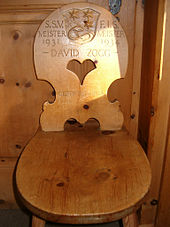David Zogg
David Zogg (born December 18, 1902 in Azmoos , † July 26, 1977 in Arosa ) was a Swiss ski racer and mountaineer . His nickname was "Vitter".
biography

The brother of Nini von Arx-Zogg , who was also known as Vitter Zogg in his Swiss homeland , won the first World Ski Championships in slalom in 1931 and the gold medal in downhill and combined at the World Ski Championships in 1934 . The 1931 World Championship slalom was scored “unofficially”, however, because the race was held in just one run - the warm weather prevented a second run. The medals, which were actually not presented at all, were listed as given in many media reports and reference works and the FIS has now also confirmed them. In 1931 Zogg became Swiss ski champion (combination cross-country skiing / jumping ) and in 1934 Swiss champion in downhill skiing .
In the 1930s, Zogg was seen as a skiing supporting actor directed by Arnold Fanck in the films Stürme über dem Mont Blanc (1930, partly shot in Arosa) and The White Rush - New Wonder of the Snowshoe (1931, shot in Austria), both with Leni Riefenstahl as the leading actress. In 1934 he appeared as “Bergführer Theodor” in the feature film White Majesty , which was made under Anton Kutters direction in Switzerland. Zogg later got involved in the Arosa ski school , which he was director from 1939 to 1974.
Zogg was also known as a mountaineer. In 1932 he worked with Fritz Steuri as a mountain guide and glacier expert on the six-month “Universal Fanck Greenland Expedition” on the west coast of Greenland , led by director Arnold Fanck , where the film SOS Iceberg was shot.
In 1939 he took part with André Roch and Fritz Steuri in the first Himalayan expedition to the Garhwal region organized by the Swiss Foundation for Alpine Research (SSAF) . The group achieved the first ascent of the 7,066 meter high Dunagiri on July 5th, the 6,714 meter high Ghauri Parbat on August 18th and the 6156 meter high Rataban .
When attempting the first ascent of the 7138 meter high Chaukhamba I (Badrinath), they were caught in an avalanche in their tent on September 10 and carried away several hundred meters. They were not injured, but two porters died. When they found out about the outbreak of World War II in Europe, they had to cancel the expedition.
literature
- Hans Danuser : ski racer David Zogg . In: Bündner Jahrbuch. Volume 31, Chur 1989, pp. 69-75.
- Karl Erb : Fascination downhill. Everything about the supreme alpine discipline . Zurich 1985 (here pp. 20–31 and p. 40.)
Web links
- Adolf Collenberg: David Zogg. In: Historical Lexicon of Switzerland .
- David Zogg in the database of Ski-DB (English)
- David Zogg in the Internet Movie Database (English)
Individual evidence
- ↑ See Swiss Ski School Arosa (Ed.): 60 Years of the Swiss Ski School Arosa . Jona 1993 (new, expanded cover), here p. 7, p. 14 ff and p. 70.
- ^ Rudolf Rubi : From mountain farming village to tourist resort: hospitality, alpinism. (= In the valley of Grindelwald . Volume II). Verlag Sutter Druck, Grindelwald 1986, p. 207.
- ↑ Expedition supported by SFAR. Swiss Himalayan Expedition 1939: Garhwal. Excerpt from: Swiss Foundation for Alpine Research 1939 to 1970. Zurich 1972. SSAF website, accessed on November 3, 2011.
- ↑ Swiss in the Himalaya 1939 to 1951. 1939: The four members of the Swiss Himalaya Expedition. SSAF website, accessed November 3, 2011.
- ↑ Alexander Troller: André Roch: 90 ans de passion pour la montagne. In: The mountain hare. 35th yearbook of the Swiss Academic Ski Club SAS. 1991-1996. Pp. 129-143.
- ^ Rudolf Rubi : From mountain farming village to tourist resort: hospitality, alpinism. (= In the valley of Grindelwald . Volume II). Verlag Sutter Druck, Grindelwald 1986, pp. 217-218.
| personal data | |
|---|---|
| SURNAME | Zogg, David |
| BRIEF DESCRIPTION | Swiss skier |
| DATE OF BIRTH | December 18, 1902 |
| PLACE OF BIRTH | Azmoos |
| DATE OF DEATH | July 26, 1977 |
| Place of death | Arosa |